
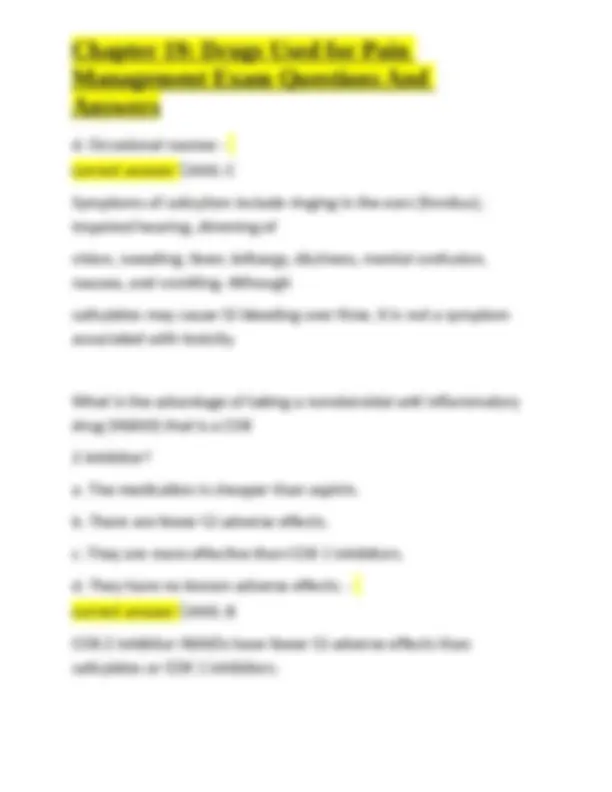
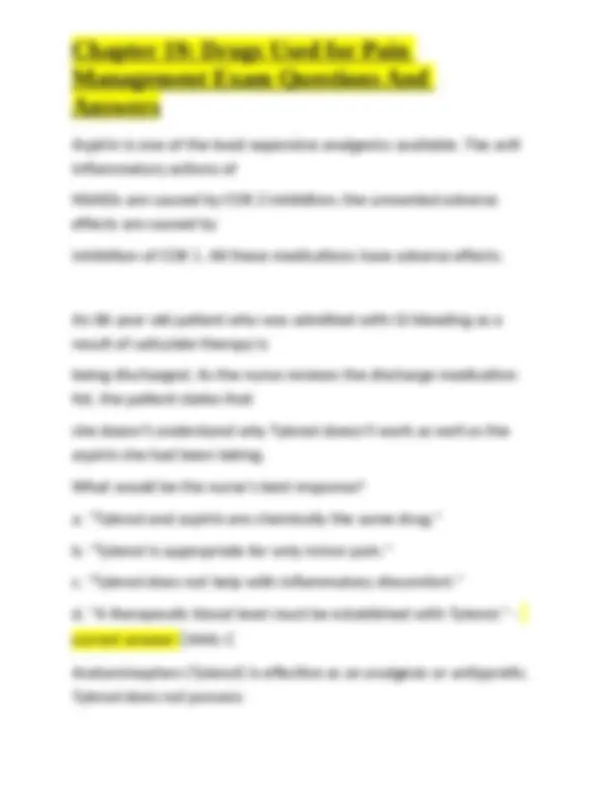

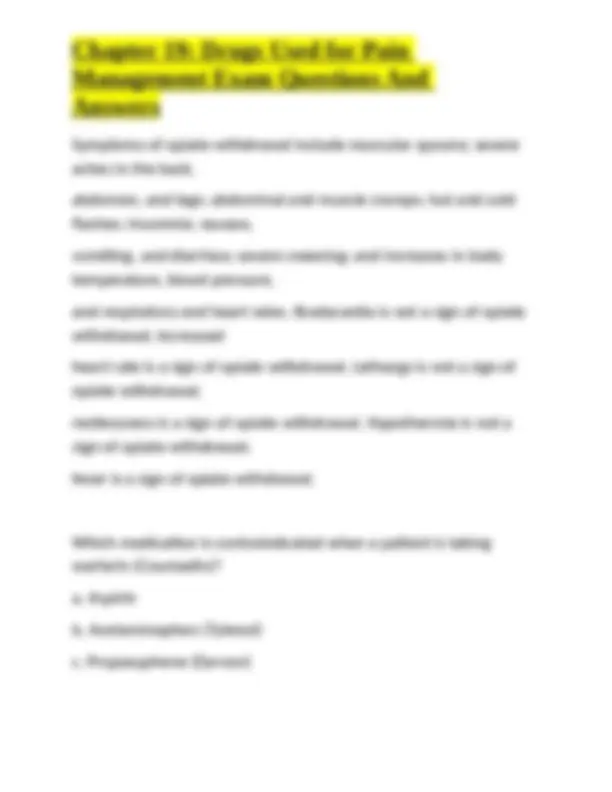
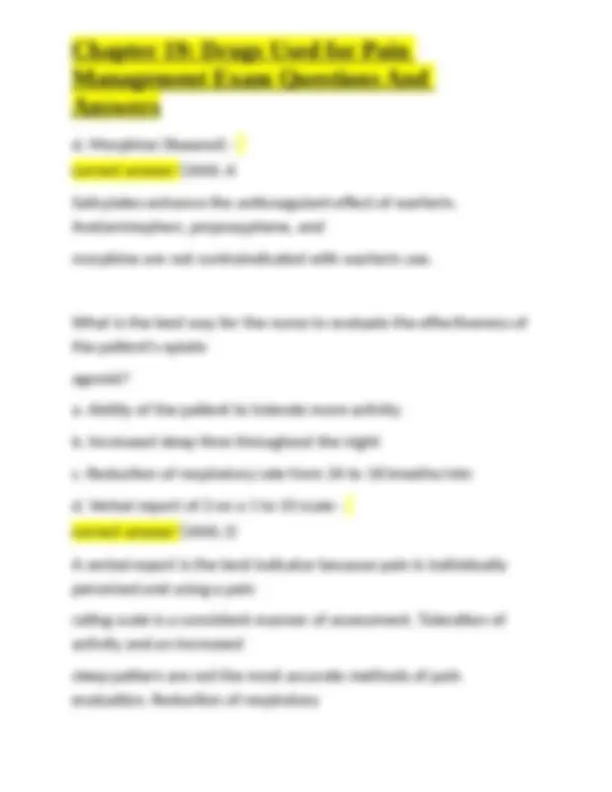
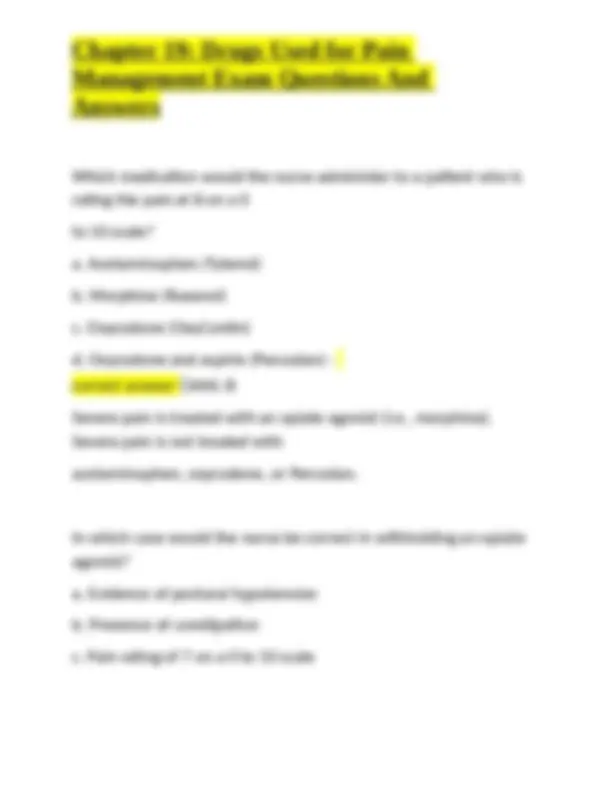
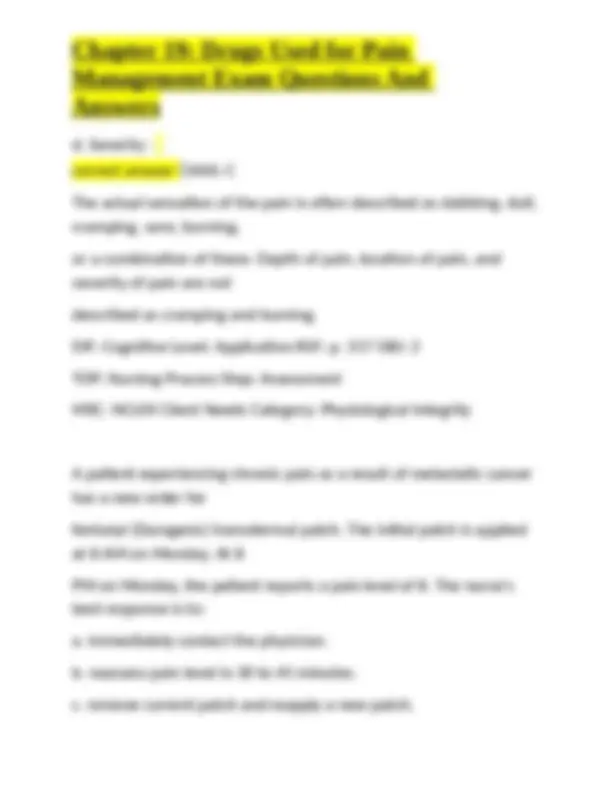
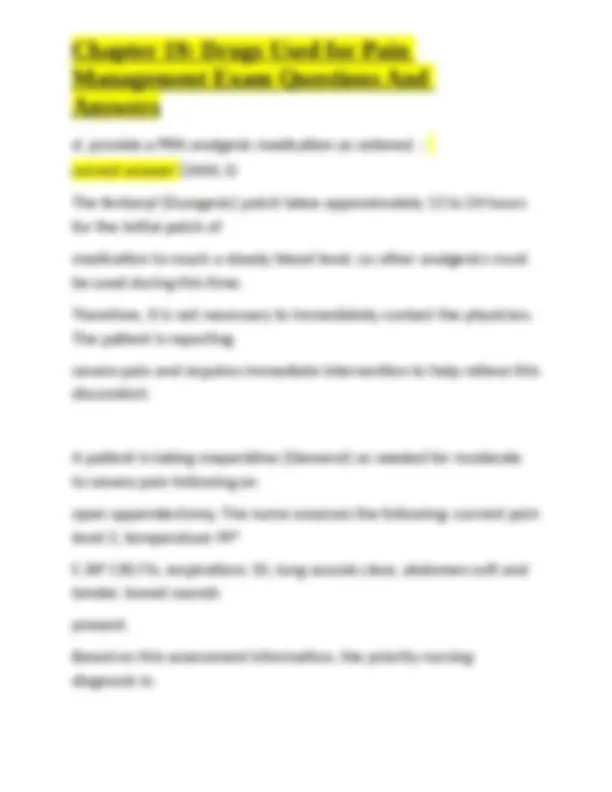
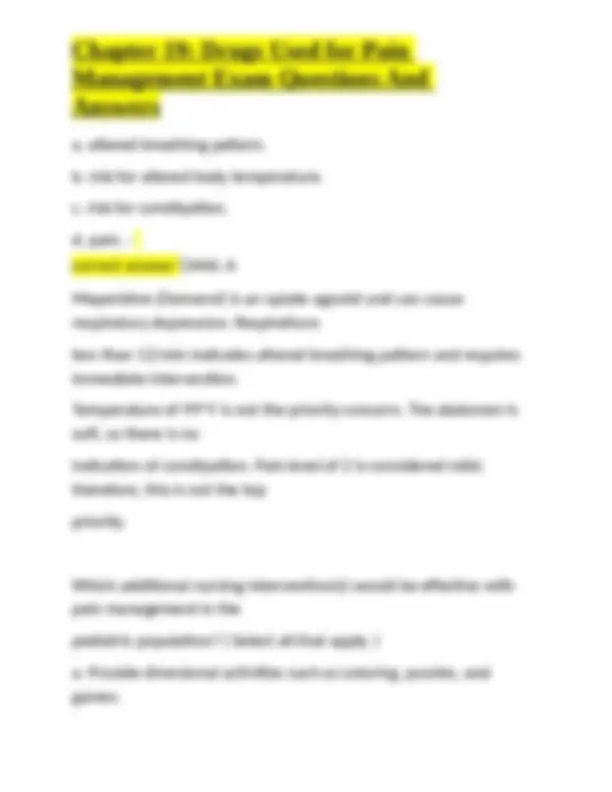
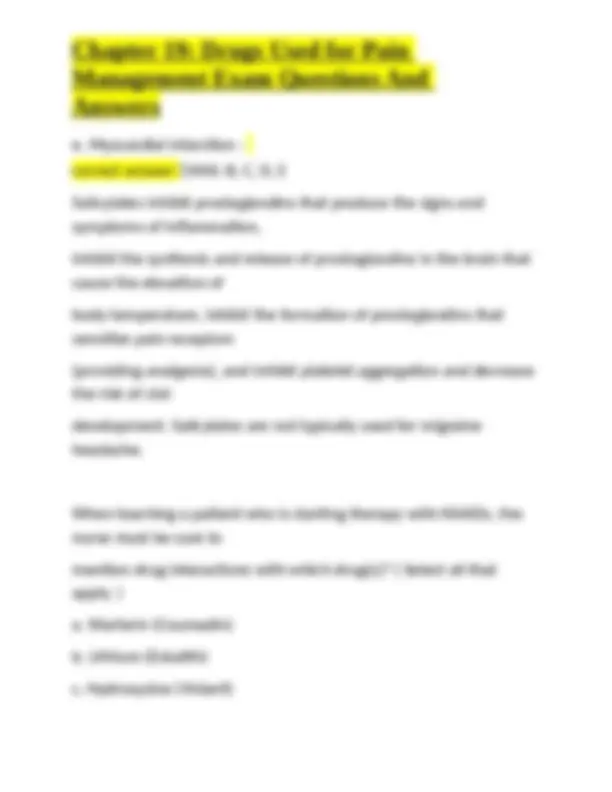
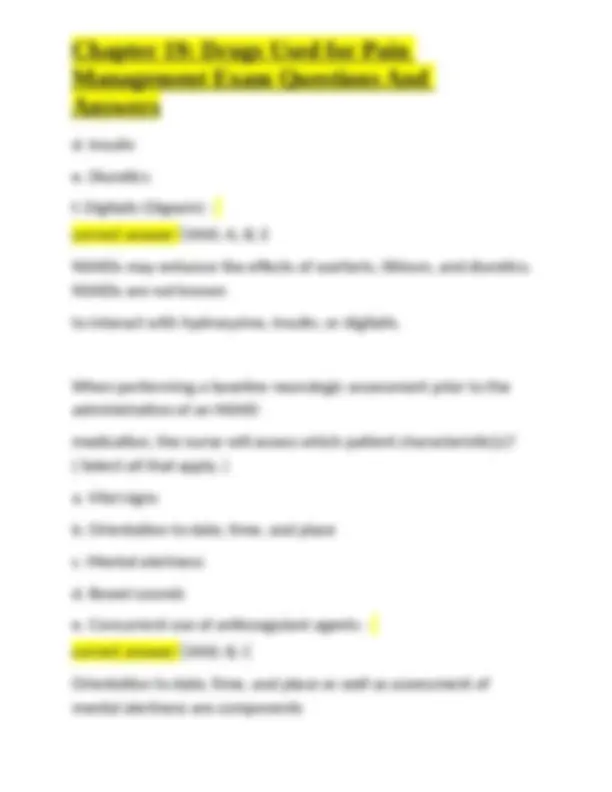
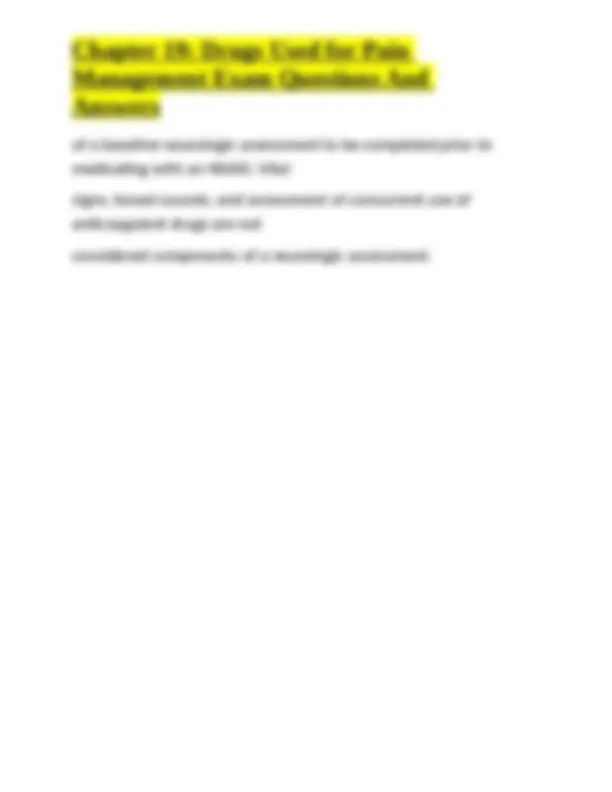


Study with the several resources on Docsity

Earn points by helping other students or get them with a premium plan


Prepare for your exams
Study with the several resources on Docsity

Earn points to download
Earn points by helping other students or get them with a premium plan
Community
Ask the community for help and clear up your study doubts
Discover the best universities in your country according to Docsity users
Free resources
Download our free guides on studying techniques, anxiety management strategies, and thesis advice from Docsity tutors
Chapter 19: Drugs Used for Pain Management Exam Questions And Answers
Typology: Exams
1 / 20

This page cannot be seen from the preview
Don't miss anything!













The nurse is completing an assessment on a nonverbal adult patient. Which type of pain scale assessment tool is the most accurate to use? a. TPPPS b. FLACC c. POCIS d. MOPS - correct answer ✅ANS: B The Face, Legs, Activity, Cry, Consolability (FLACC) scale would be used to assess pain in the nonverbal patient. The Toddler Preschooler Postoperative Pain Scale (TPPPS), Pain Observation Scale for Young Children (POCIS), and Modified Objective Pain Scale (MOPS) would not be appropriate for this patient. Which action will the nurse take when a patient receiving morphine sulfate via percutaneous coronary angioplasty (PCA) has a shallow, irregular respiratory rate of 6 breaths/min?
a. Elevate the patient's head of bed to facilitate lung expansion. b. Increase the patient's primary intravenous (IV) flow rate. c. Complete the FLACC scale. d. Notify the health care provider and prepare to administer naloxone (Narcan). - correct answer ✅ANS: D The patient is exhibiting signs of respiratory depression. Administration of the antidote naloxone would be the most appropriate nursing intervention. Lung expansion or increasing the primary IV infusion rate would not relieve respiratory depression. Assessing the patient's pain at this point is a lesser priority than treating the respiratory depression. Which patient assessment would indicate to the nurse that salicylate toxicity is occurring? a. Gastrointestinal (GI) bleeding b. Increased bleeding times c. Tinnitus
Aspirin is one of the least expensive analgesics available. The anti inflammatory actions of NSAIDs are caused by COX 2 inhibition; the unwanted adverse effects are caused by inhibition of COX 1. All these medications have adverse effects. An 86 year old patient who was admitted with GI bleeding as a result of salicylate therapy is being discharged. As the nurse reviews the discharge medication list, the patient states that she doesn't understand why Tylenol doesn't work as well as the aspirin she had been taking. What would be the nurse's best response? a. "Tylenol and aspirin are chemically the same drug." b. "Tylenol is appropriate for only minor pain." c. "Tylenol does not help with inflammatory discomfort." d. "A therapeutic blood level must be established with Tylenol." - correct answer ✅ANS: C Acetaminophen (Tylenol) is effective as an analgesic or antipyretic. Tylenol does not possess
any anti inflammatory activity and is therefore ineffective in relieving symptoms related to inflammation. Tylenol and aspirin are distinctly different drugs. Tylenol can be useful in the relief of moderate pain. Tylenol can be effective in a single dose, without needing treatment over a period of time. What term is used to define an awareness of pain? a. Tolerance b. Threshold c. Perception d. Sensation - correct answer ✅ANS: C Pain perception, also known as nociception, is an individual's awareness of the feeling of pain. Pain tolerance is an individual's ability to endure pain. Pain threshold is the point at which an individual first acknowledges or interprets a sensation as being painful. Pain is a
the next pain assessment to evaluate the effectiveness of the medication? a. 10 minutes b. 30 minutes c. 1 hour d. 2 hours - correct answer ✅ANS: B Evaluation of pain effectiveness of parenteral pain medications needs to occur within 15 to 30 minutes of administration. Ten minutes, 1 hour, and 2 hours are not accurate time frames to evaluate the effectiveness of parenteral medications Which sign or symptom displayed by a patient would be indicative of opiate withdrawal? a. Bradycardia b. Diarrhea c. Lethargy d. Hypothermia - correct answer ✅ANS: B
Symptoms of opiate withdrawal include muscular spasms; severe aches in the back, abdomen, and legs; abdominal and muscle cramps; hot and cold flashes; insomnia; nausea, vomiting, and diarrhea; severe sneezing; and increases in body temperature, blood pressure, and respiratory and heart rates. Bradycardia is not a sign of opiate withdrawal; increased heart rate is a sign of opiate withdrawal. Lethargy is not a sign of opiate withdrawal; restlessness is a sign of opiate withdrawal. Hypothermia is not a sign of opiate withdrawal; fever is a sign of opiate withdrawal. Which medication is contraindicated when a patient is taking warfarin (Coumadin)? a. Aspirin b. Acetaminophen (Tylenol) c. Propoxyphene (Darvon)
Which medication would the nurse administer to a patient who is rating the pain at 8 on a 0 to 10 scale? a. Acetaminophen (Tylenol) b. Morphine (Roxanol) c. Oxycodone (OxyContin) d. Oxycodone and aspirin (Percodan) - correct answer ✅ANS: B Severe pain is treated with an opiate agonist (i.e., morphine). Severe pain is not treated with acetaminophen, oxycodone, or Percodan. In which case would the nurse be correct in withholding an opiate agonist? a. Evidence of postural hypotension b. Presence of constipation c. Pain rating of 7 on a 0 to 10 scale
d. Respiratory rate of 10 breaths/min - correct answer ✅ANS: D The nurse would withhold the medication if respirations are less than 12 breaths/min. Postural hypotension is a common adverse effect that most frequently occurs when therapy is initiated. Providing for patient safety is important, but it does not warrant withholding the medication. What information is most accurate regarding the nurse's understanding of pain management? a. Older patients have difficulty describing their pain level. b. Encourage patients to report pain before the pain becomes too severe. c. Use the smallest dose of medication possible to control pain. d. Pain medication administration ordered PRN will maintain a constant blood level. - correct answer ✅ANS: B
d. Severity - correct answer ✅ANS: C The actual sensation of the pain is often described as stabbing, dull, cramping, sore, burning, or a combination of these. Depth of pain, location of pain, and severity of pain are not described as cramping and burning. DIF: Cognitive Level: Application REF: p. 317 OBJ: 2 TOP: Nursing Process Step: Assessment MSC: NCLEX Client Needs Category: Physiological Integrity A patient experiencing chronic pain as a result of metastatic cancer has a new order for fentanyl (Duragesic) transdermal patch. The initial patch is applied at 8 AM on Monday. At 8 PM on Monday, the patient reports a pain level of 8. The nurse's best response is to: a. immediately contact the physician. b. reassess pain level in 30 to 45 minutes. c. remove current patch and reapply a new patch.
d. provide a PRN analgesic medication as ordered. - correct answer ✅ANS: D The fentanyl (Duragesic) patch takes approximately 12 to 24 hours for the initial patch of medication to reach a steady blood level, so other analgesics must be used during this time. Therefore, it is not necessary to immediately contact the physician. The patient is reporting severe pain and requires immediate intervention to help relieve this discomfort. A patient is taking meperidine (Demerol) as needed for moderate to severe pain following an open appendectomy. The nurse assesses the following: current pain level 2, temperature 99° F, BP 130/76, respirations 10, lung sounds clear, abdomen soft and tender, bowel sounds present. Based on this assessment information, the priority nursing diagnosis is:
b. Allow uninterrupted sleep and rest. c. Perform hygiene measures. d. Encourage parental participation with caregiving to diminish the child's anxiety. e. With the health care provider's approval, encourage the child to drink eight to ten 8 ounce glasses of fluid daily. - correct answer ✅ANS: A, B, C, D Diversional activities, adequate sleep, comfort measures (such as hygiene), and parental participation with care are alternative nursing interventions that may be used in pain management. Forcing fluids is not likely to assist with pain management in the child. Which common adverse effect(s) is/are associated with opiate agonists? (Select all that apply.) a. Dizziness b. Orthostatic hypotension
c. Respiratory depression d. Confusion e. Diarrhea f. Urinary urgency - correct answer ✅ANS: A, B, C, D Dizziness, orthostatic hypotension, respiratory depression, and confusion are adverse effects associated with opiate agonists. Constipation, not diarrhea, is an adverse effect associated with opiate agonists. Urinary retention, not urgency, is an adverse effect associated with opiate agonists. Which condition(s) may be managed by salicylates? ( Select all that apply. ) a. Migraine headache b. Swollen joints c. Fever d. Muscle aches
d. Insulin e. Diuretics f. Digitalis (Digoxin) - correct answer ✅ANS: A, B, E NSAIDs may enhance the effects of warfarin, lithium, and diuretics. NSAIDs are not known to interact with hydroxyzine, insulin, or digitalis. When performing a baseline neurologic assessment prior to the administration of an NSAID medication, the nurse will assess which patient characteristic(s)? ( Select all that apply. ) a. Vital signs b. Orientation to date, time, and place c. Mental alertness d. Bowel sounds e. Concurrent use of anticoagulant agents - correct answer ✅ANS: B, C Orientation to date, time, and place as well as assessment of mental alertness are components
of a baseline neurologic assessment to be completed prior to medicating with an NSAID. Vital signs, bowel sounds, and assessment of concurrent use of anticoagulant drugs are not considered components of a neurologic assessment.